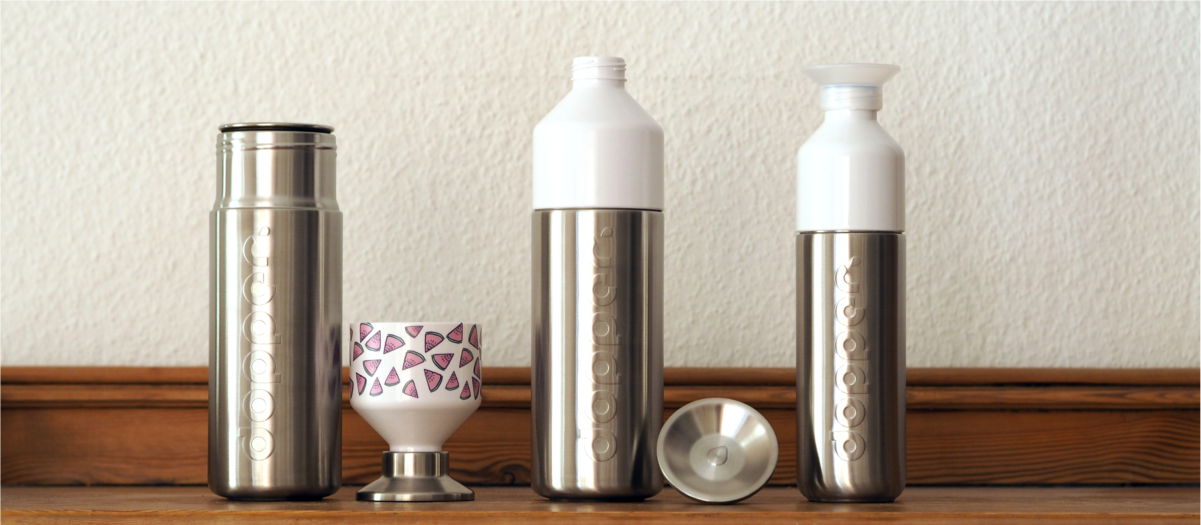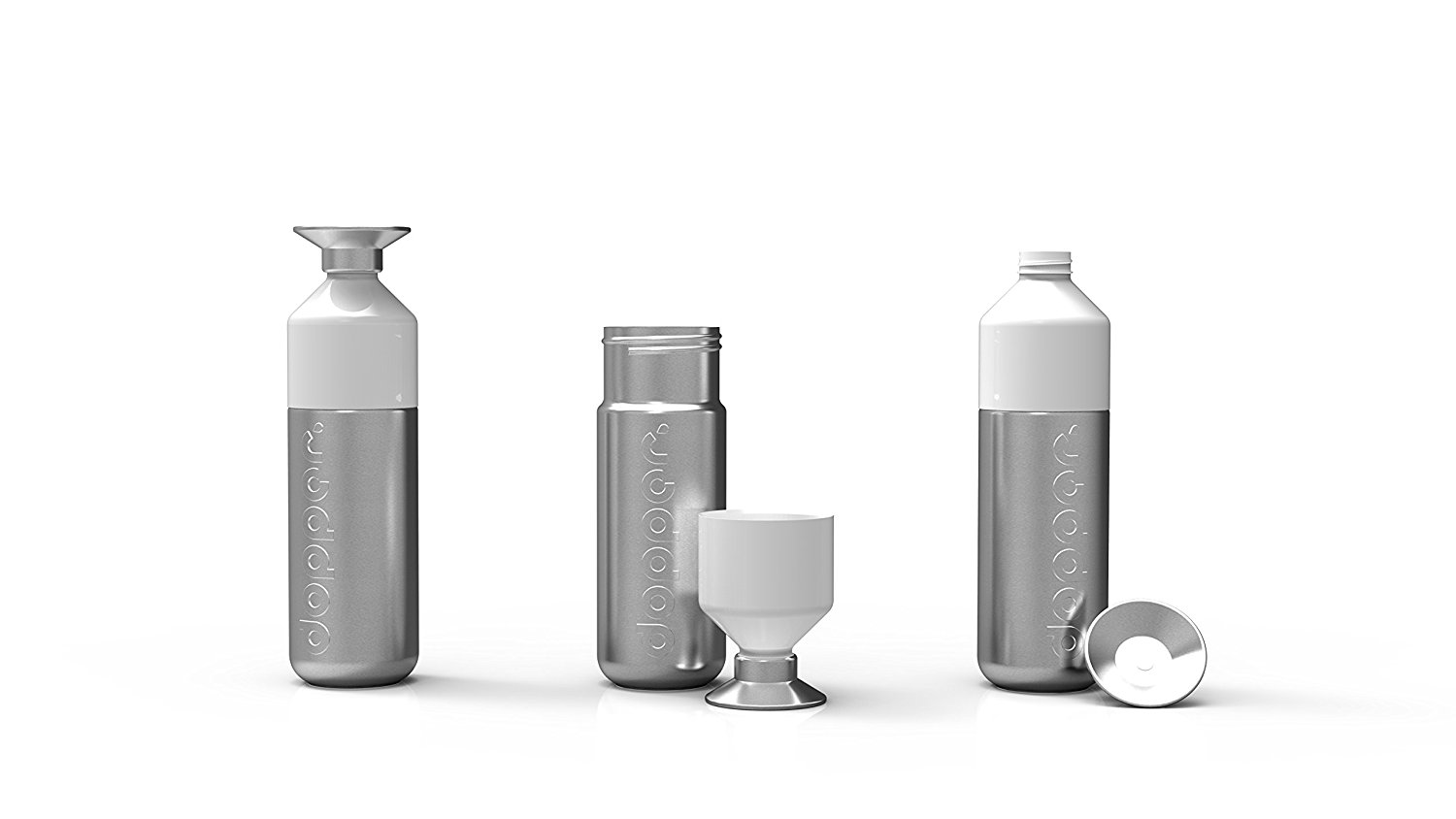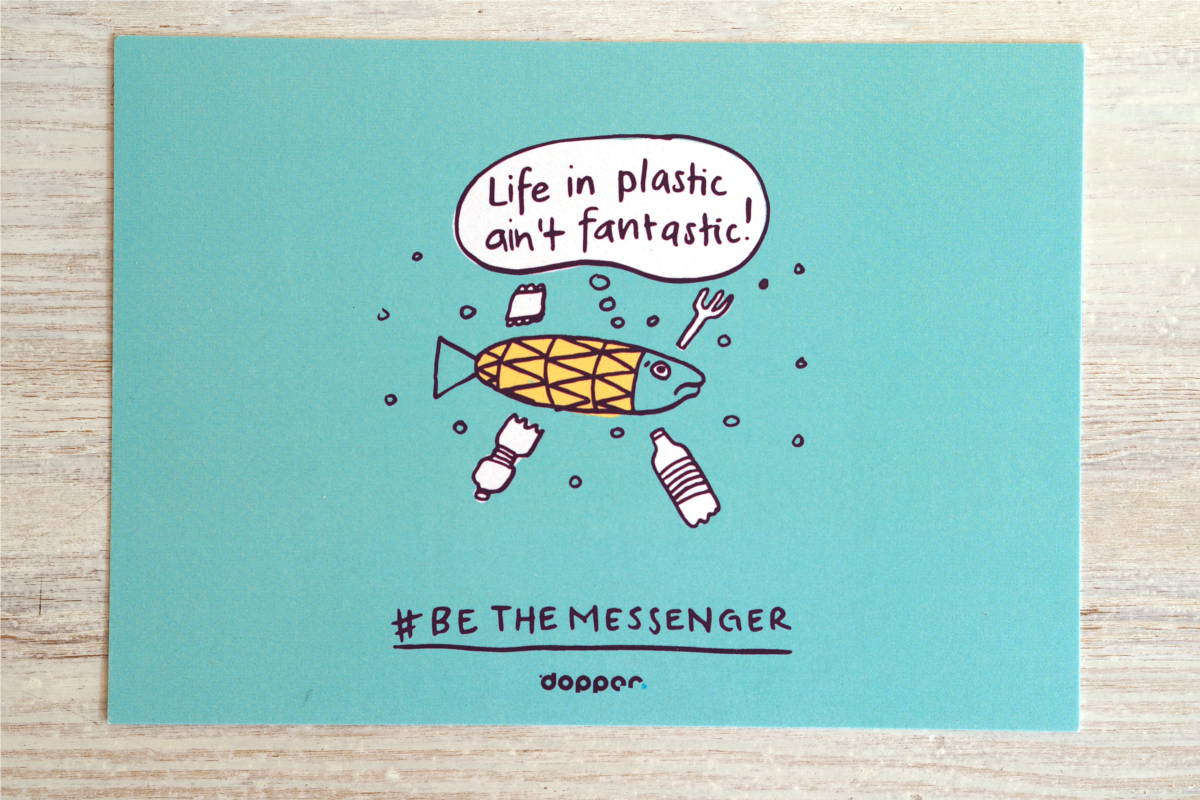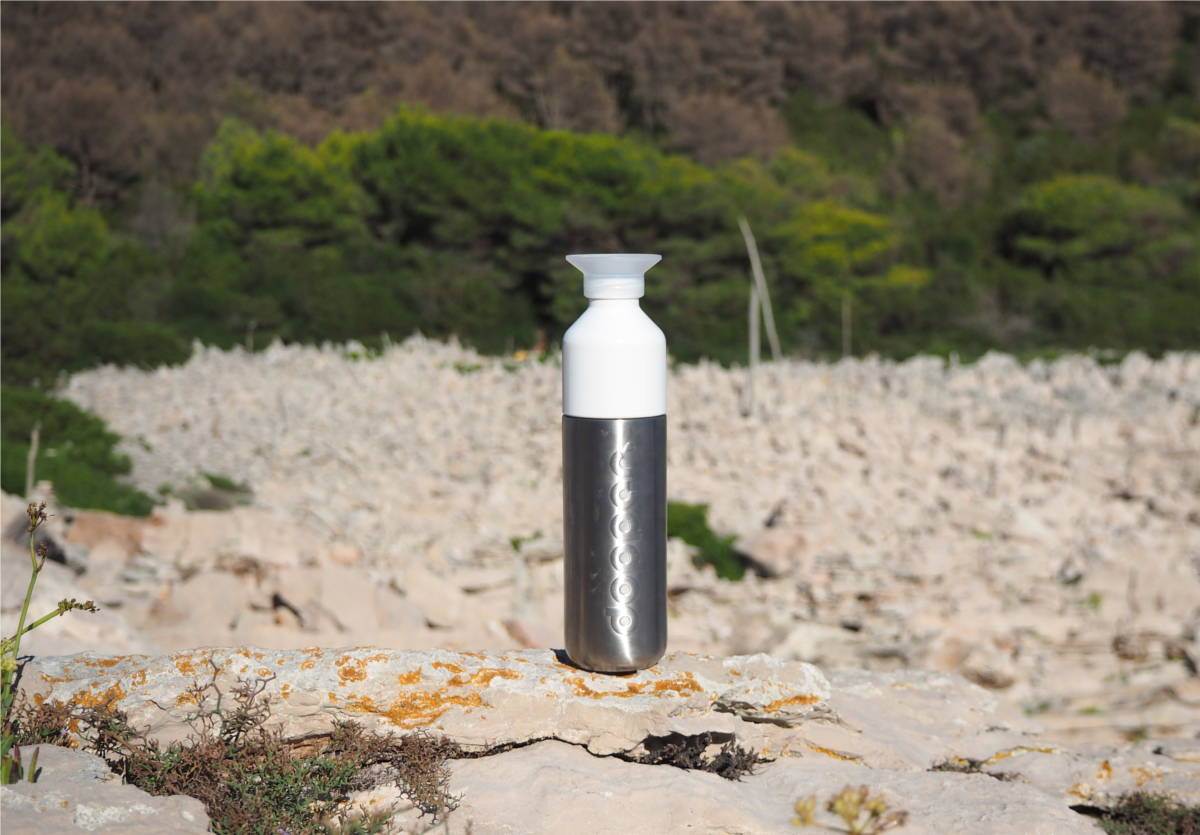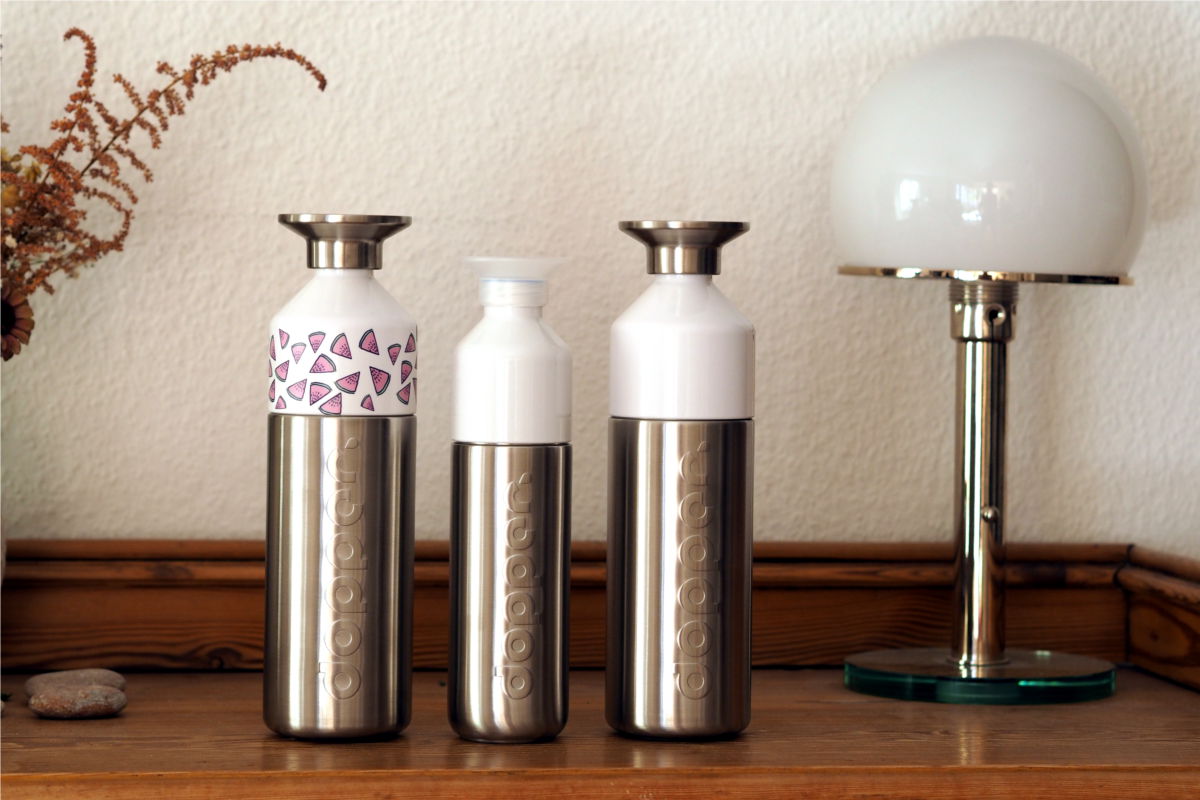Die Trinkflaschen von Dopper aus den Niederlanden haben mich überzeugt, nicht nur qualitativ (Test der Trinkflasche aus Edelstahl), auch das nachhaltige Konzept (Cradle to Cradle) und die Mission von Dopper sind lobenswert. Nachhaltige Marken mit überzeugenden Produkten unterstütze ich gerne und konnte Charlotte van den Broek (Marketing Executive Germany bei Dopper) für ein 6 Fragen Interview gewinnen.
Besonders spannend finde ich, mit den Dopper Trinkflaschen ein Cradle to Cradle zertifiziertes Produkt gefunden zu haben, welches für jedermann nützlich ist und alltägliche Verwendung findet. Charlotte von Dopper konnte ich Fragen zu den Herausforderungen bei der Zertifizierung, Transparenz und den sozialen Projekten von Dopper stellen.
Dopper im Interview #4
6 Fragen an Charlotte van den Broek / Marketing Executive Germany / Dopper
1Was sind die Herausforderungen bei einer Cradle to Cradle Zertifizierung?
Charlotte / Dopper: Eine große Herausforderung ist, dass es viel Zeit benötigt, um alle richtigen Informationen, Lebensmittelkontakt-Zertifikate oder signierte Dokumente von den Rohstofflieferanten zu erhalten, besonders wenn diese mit Zwischenhändler arbeiten und man nicht den direkten Kontakt zum Rohstofflieferanten hat.
2Die Idee hinter Cradle to Cradle ist die abfallfreie Wirtschaftsweise und Produkte mit geschlossenen und möglichst unendlichen Kreisläufen der Wiederverwertung. Auch die Dopper Flasche wird natürlich nicht ewig halten. Defekte Teile der Trinkflasche können kostenlos an Dopper geschickt werden, damit diese wieder verarbeitet werden können. Was passiert beispielsweise mit den Flaschen und Verschlusskappen aus Polypropylen?
Charlotte / Dopper: Kaputte Flaschen und Verschlüsse, die an die Dopper Hauptgeschäftstelle geschickt werden, werden monatlich an die Fabrik VDL mit Sitz in Emmen weitergeleitet. Die Fabrik prüft zunächst alle Komponenten, danach werden die Komponenten an ein Recyclingunternehmen in Deutschland versandt, das dem PP-Material in den Komponenten ein zweites Leben gibt. Daraus entstehen dann beispielsweise Pflanzentöpfe oder andere ähnliche Produkte.
3Ich habe gesehen, dass die Dopper Steel Trinkflasche in China hergestellt werden. Wie passt das in das gesamte Konzept des umweltfreundlichen und transparenten Produkts? Was spricht gegen eine Produktion in Europa?
Charlotte / Dopper: Um die Dopper Trinkflasche aus Edelstahl in den Niederlanden zu produzieren, müssen wir sicherstellen, dass wir viele Flaschen verkaufen werden. Es muss viel Geld investiert werden, bevor man überhaupt eine Massenproduktion starten kann. Dies liegt daran, dass der gesamte Prozess automatisiert werden muss.
Wir arbeiten nur mit chinesischen Fabriken, die ISO9001 und ISO14001 zertifiziert sind. Außerdem fordern wir ein soziales Audit in den chinesischen Fabriken, welche von Dritten durchgeführt wird. Die Prüfung der sozialen Standards in den Fabriken basiert auf dem Verhaltenskodex von BSCI (Business Social Compliance Initiative). Wir als Dopper sind ein Mitglied von BSCI und BSCI setzt sich für gute Arbeitsbedingungen in den Fabriken ein, besonders in Fabriken, die nicht in westlichen Ländern angesiedelt sind, wie China.
Wir fordern auch eine transparente Stückliste, so dass wir wissen, woher die Rohstoffe kommen, die in den Edelstahl Trinkflaschen von Dopper verwendet werden. Außerdem versuchen wir, die Rohstofflieferanten zu besuchen. Im vergangenen Jahr 2016, haben wir den Lieferanten besucht, der den Edelstahl für unsere Trinkflaschen herstellt.
4Cradle to Cradle ist die wirklich nachhaltige Alternative zum Prinzip „Ausbeuten – produzieren – wegwerfen“. Wie wirkt sich das Cradle to Cradle Konzept auf euer Arbeitsleben und den Arbeitsplatz bei Dopper aus?
Charlotte / Dopper: Im Büro haben wir verschiedene Behälter, um Abfälle zu trennen und wir erlauben keine Einwegflaschen. Wir sind ein PET-freies Unternehmen, das bedeutet, dass keine Einweg-Plastik-Flaschen angeboten oder verkauft werden. Wir trinken aus unseren Doppler Flaschen oder Gläsern und trinken nur Wasser aus dem Wasserhahn. Darüber hinaus haben wir ein laufendes Projekt zur Unterstützung und Motivation anderer Unternehmen PET-frei zu werden. Bei petfreeworld.com können Unternehmen, die keine PET-Wasserflaschen verwenden, ein Zertifikat abonnieren. Diese zertifizierten Unternehmen erhalten dann ein Paket von uns, das das Projekt unterstützt. ‚PET Free‘ ist eine Bewegung, mit der wir Menschen und Unternehmen rund um die Welt auf die Umweltverschmutzung aufmerksam machen wollen. Viele Änderungen (wie z. B. keine PET-Flaschen mehr anzubieten) sind nicht schwierig in der Umsetzung, haben aber eine große und positive Auswirkung auf die Umwelt.
5Das Dopper Sortiment besteht aktuell hauptsächlich aus der Wasserflasche aus Plastik oder Stahl, in vielen verschiedenen Farben. Plant ihr für die Zukunft weitere Cradle to Cradle zertifizierte Produkte? Vielleicht gewährst du uns einen Blick in die Dopper Entwicklungsabteilung?
Charlotte / Dopper: Im Moment ist nur das Dopper Original CtoC zertifiziert, aber wir planen auch die Stahlflaschen im Jahr 2018 zu zertifizieren. Dies könnte die ‚Solid Steel‘, die Steel 800 ML oder andere kommende Innovationen sein, die aber noch geheim sind! Fortsetzung folgt …
Es dauert übrigens mindestens 6 bis 12 Monate, um ein neues Produkt nach Cradle to Cradle zu zertifizieren!
6Zu Dopper gehört auch eine Stiftung, die Dopper Foundation. Diese setzt sich seit vielen Jahren für sauberes Trinkwasser und eine plastikfreie Umwelt ein. 5% des Netto-Umsatzes von Dopper gehen direkt an Stiftung. Mit jedem Einkauf werden die Projekte der Stiftung unterstützt. Welche Wasserprojekte unterstützt ihr aktuell und welche konkreten Erfolge konntet ihr in der Vergangenheit mit den Projekten erzielen?
Charlotte / Dopper: Die Dopper Foundation investiert in den Wandel: in Lösungen der durch Plastik verursachten Probleme, die über die durch Wasserflaschen verursachten Probleme hinausgehen. eil die Menschen sauberes Trinkwasser brauchen, bevor sie sich für nachhaltige Alternativen zu Plastikflaschen entscheiden können, investieren wir in Wasser- und Müllprojekte in Nepal.
ÜBER NEPAL
In seinen zerklüfteten Berggipfeln beherbergt Nepal die zweitgrößte Süßwasserressource der Welt. Es ist also ziemlich ironisch, dass weniger als die Hälfte der Bevölkerung Zugang zu sicherem Trinkwasser hat. Schmelzwasser von den Gletschern fließt die Berge hinunter, aber es erreicht nicht alle nepalesischen Menschen. Darüber hinaus ist das Wasser durch Abfälle verunreinigt. Jedes Jahr sterben 10.000 Kindern unter fünf Jahren durch wasserbedingte Krankheiten. Mehr als 2.000 Nepalesen verlassen jeden Tag das Land in der Hoffnung anderswo Arbeit zu finden, denn Nepal das zweitärmste Land Asiens nach Afghanistan. Betrachtet man das Land aus dieser Perspektive, mag Nepal wie ein Albtraum sein, aber nicht für uns: wir sehen ein Land der grenzenlosen Träume. Denn überall, wo es Probleme gibt, sehen lokale ‚Changemaker‘ auch Chancen zur Veränderung. Die Dopper Foundation will in diese Pioniere investieren.
Fakten und Zahlen zu Nepal
- Bevölkerung: 30 Millionen
- Hauptstadt: Kathmandu
- Lebenserwartung (M / F): 65/69
- 10% haben keinen Zugang zu sicherem Trinkwasser
- 66% haben keinen Zugang zu einer sicheren Abwasserentsorgung
WASSER UND SANITATION
Seit dem Verkauf der ersten Dopper Flasche, spendete Dopper Geld für die Simavi Wasserprojekte in Nepal. Zuerst im südlichen Bezirk von Ruphendi und später in den Bezirken Gorkha und Baglung. Durch die Installation von 473 Wasserpunkten und 2.674 Toiletten haben 11.889 Menschen einen besseren Zugang zu Trinkwasser bekommen und 19.992 Personen haben jetzt Zugang zu Sanitäranlagen. Im Januar 2017 haben wir gemeinsam mit unserem lokalen Partner Sebac ein neues Projekt in den wunderschönen Sindhupalchowk- und Dolkha-Bezirken ins Leben gerufen. Ziel ist es, in den nächsten drei Jahren mindestens 10.000 Menschen mit Zugang zu sauberem Trinkwasser zu versorgen.
Dank des wachsenden Umsatzes ist auch der Betrag, der in Nepal investiert wird – durch die Stiftung – ebenfalls gewachsen. Die Gesamtsumme, die die Dopper Foundation bisher investiert hat, beträgt 343.932 €.
WAS MACHEN WIR?
- Wissen über Wasser, Toiletten & Hygiene verbreiten
- Auffangen von Regenwasser
- Installation und Wartung von Rohrleitungen
- Bau und Instandhaltung von Toiletten
Vielen Dank Charlotte, dass du dir die Zeit genommen hast meine 6 Fragen zu beantworten! Ich bin gespannt, welche Produkte Dopper in Zukunft noch auf den Markt bringt und wünsche euch ganz viel Erfolg!
zum Test der Edelstahl Trinkflasche von Dopper
The water bottles from Dopper convinced me not only qualitatively (test of the drinking bottle made of stainless steel), also the sustainable concept (Cradle to Cradle) and the mission of Dopper are powerful. I would like to support sustainable brands with convincing products and was able to win Charlotte van den Broek (Marketing Executive Germany at Dopper) for a 6 questions interview.
With the Dopper water bottles I found a Cradle to Cradle certified products which are useful for everyone and for everyday use. Here you will find some information about Dopper’s certification, transparency and social projects.
6 questions to Charlotte van den Broek / Marketing Executive Germany / Dopper
1What are the challenges of a Cradle to Cradle certification?
Charlotte / Dopper: Big challenge is that is takes time to get all the right information, food contact certificates, or signed documents from the raw material suppliers, especially when you work with distributors from the Raw material Suppliers instead of directly.
2The idea behind Cradle to Cradle is the waste-free economy and products with closed and possibly infinite cycles of recycling. But also the Dopper bottle will not last forever. Broken parts of the water bottle can be sent to Dopper free of charge so that they can be recycled. What happens with the broken bottles and caps made of polypropylene?
Charlotte / Dopper: Broken bottles and Caps which are sent to Dopper HQ will be send on a monthly basis to the factory VDL based in Emmen. The factory first checks all the components, after that the components are send to a recycling company in Germany who gives the PP material in the components a second life. Think of plant pots or other similar products.
3I have seen that the Dopper Steel bottle is made in China. How does this choice of the production country fit into the whole concept of the environmentally friendly and transparent product? What speaks against a production in Europe?
Charlotte / Dopper: In order to produce the Steel in the Netherlands we need to make sure we are going to sell a lot bottles. A large investment needs to be done before you can even start with the first mass production. This is due to the fact that the entire process needs to be automated.
Note that we only work with Chinese factories that are ISO9001 and ISO14001 certified. Also we demand a social audit in the factory by a third party. This social audit is based on the code of conduct from BSCI (Business Social Compliance Initiative). We as Dopper are a member of BSCI and BSCI stives for good working conditions in factory’s especially in factory’s that are not based in western country, such as China.
Also we demand a transparent bill of material so we know where the raw materials are coming from which are used in the steel bottles and also we try to visit the raw material suppliers. Last year in 2016 we visited the suppliers that manufactures the stainless steel that is used for the bottles.
4Cradle to Cradle is the truly sustainable alternative to the „exploit – produce – throw away“ principle. How does the Cradle to Cradle concept affect your working life and workplace at Dopper?
Charlotte / Dopper: In the office we have different bins to separate waste and we do not allow any single use pet bottles. We are a PET-free company which entails that no single use plastic water bottles are offered or sold, we drink from Doppers or glass and we only drink water from the tap. Moreover, we have an ongoing project of supporting and pushing other companies to become PET Free. At petfreeworld.com companies that do not use PET water bottles can subscribe for a certificate. Companies will then receive a package which supports the project to tell the story onwards. PET Free is a movement with which we want to make people and companies all around the world aware of plastic pollution. Moreover, that making some changes (such as not offering PET Free water bottles) is not a difficult implementation but does have a lot of impact on the environment.
5The Dopper product assortment currently mainly consists of the water bottle made of plastic or steel, in many different colors. Are you planning any other Cradle to Cradle certified products? Maybe you give us a look into the Dopper development department and your „future lab“?
Charlotte / Dopper: At the moment only the Dopper Original is CtoC certified, but we are planning to certify the Steel bottles in 2018 as well. This could be the Solid Steel, Steel 800 ML or our other upcoming innovations that is in the making! To be continued…
Note that it takes ate least 6 to 12 months to certify a new product.
6Dopper is not only producing long lasting and reusable water bottles, but also operates the Dopper Foundation. For many years now, this foundation works for clean drinking water and a plastic-free environment. 5% of Dopper’s net sales go directly to the foundation, so the projects are supported with every purchase. Which water projects do you currently support and what did you achieve so far?
Charlotte / Dopper: The Dopper Foundation always looks to invest in change: in solutions for the plastic issues that go beyond those caused by water bottles. And because people need clean drinking water before they can opt for sustainable alternatives to bottled water, we invest in water and waste projects in Nepal.
ABOUT NEPAL
In its rugged mountain peaks, Nepal harbors the second largest fresh water resource in the world. It is therefore pretty ironic that less than half the population have access to safe drinking water. Melt water from the glaciers flows down the mountains, but it fails to reach all the Nepalese people. On top of this, the water is contaminated by waste being dumped in it. Each year, water-related diseases claim the lives of 10,000 children under five. And what is more, no less than 2,000 Nepalese people leave the country every single day in the hope of finding work elsewhere, as Nepal is the second poorest country in Asia, after Afghanistan. Seen through this lens, Nepal may seem like a nightmare, but not for us: we see this as a country of limitless dreams. Because wherever there are problems, local Changemakers are looking to turn these into opportunities. And the Dopper Foundation wants to invest in those pioneers.
FACTS AND FIGURES
Population: 30 million
Capital: Kathmandu
Life expectancy (M/F): 65/69
10% do not have access to safe drinking water
66% do not have access to safe sanitation
WATER AND SANITATION
Ever since the very first water bottle was sold, Dopper has been donating funds to the Simavi water projects in Nepal. First in the southern district of Ruphendi, and later in the Gorkha and Baglung districts. By installing 473 water points and 2,674 toilets, 11,889 people have gotten better access to drinking water, and 19,992 people now have access to sanitary facilities. In January 2017 we launched a new project together with our local partner Sebac, in the gorgeous Sindhupalchowk and Dolkha districts. The aim is to provide at least 10,000 people with access to clean drinking water in the next three years.
Thanks to the growing turnover, the amount that is invested in Nepal – through the Foundation – has grown as well. The total sum that Dopper Foundation is investing is €343.932,-
WHAT DO WE DO?
Spread knowledge about water, toilets & hygiene
Rainwater harvesting
Installation and maintenance of pipeplines
Construction and maintenance of toilets
NEPAL STORIES
A motley crew of storytellers travelled to Nepal to increase our understanding of the challenges that the country faces and to show what solutions the local Changemakers have already come up with. A photographer, a film maker, a writer, and a musician started at the beginning: at the foot of the mountain, and with the issues in Kathmandu. They followed the river along the Himalaya ridges, in search of the spring from which all dreams stem. Along the way, they met the Nepalese people, men and women who give us an insight into the challenges that Nepal faces today.
THANKS TO YOUR DOPPER
18,000 people have access to safe drinking water
1,924 households have access to sanitation
204 people were trained to provide information about water, sanitation and hygiene (WASH) & waste collection and processing
45 people were trained as plumbers for technical maintenance
64 campaigns in villages, 32 in schools
€ 168,217 invested from the Dopper Foundatio
Thank you Charlotte for taking the time to answer my 6 questions here on derJogger.de! I am curious which Dopper products we will see in fututre and wish you all the best!
Wer war bisher bei 6 Fragen?
Im Kurz-Interview hatte ich auch schon folgende Persönlichkeiten:
Interview #1: 6 Fragen an Anna Achilles
Interview #2: 6 Fragen an Philipp Pflieger
Interview #3: 6 Fragen an Jan Fitschen
Wie gefallen dir die Interviews?
Über ein kurzes Feedback weiter unten als Kommentaren oder auch gerne hier bei Facebook würde ich mich sehr freuen!
* IN EIGENER SACHE
Dir gefällt mein kleiner Blog derJogger.de und die Interview-Reihe „6 Fragen“? Dann zeig es, indem du derJogger.de unterstützt noch etwas bekannter zu werden. Es gibt verschiedene Möglichkeiten diese Webseite auch ohne Kosten für dich zu unterstützen:
- Amazon-Partner
Ich erhalte eine Provision, wenn du über einen Amazon-Link (sind alle mit * markiert) in einem meiner Beiträge bei Amazon einkaufst. Den Kaufpreis beeinflusst diese Provision natürlich nicht. Mögliche Einnahmen werden langfristig wieder in diesen Blog investiert, indem z.B. ein Teil der Server- und Domainkosten davon bezahlt werden.
- Socialize
Folge derJogger.de auf Facebook und bleibe auf dem Laufenden! Interessantes und Neuigkeiten rund um Laufen, Sport und Natur. Hier findest du die Facebookseite zum Blog.
- Feedback
Natürlich interessiert mich dein Feedback zu derJogger.de und zu diesem Interview. Schreib ein Kommentar und sage mir was dich bewegt!



